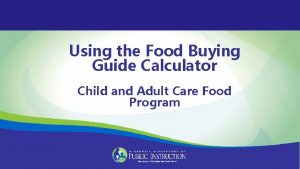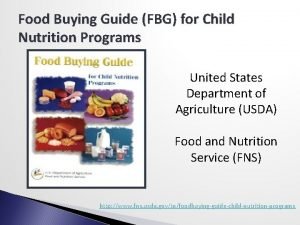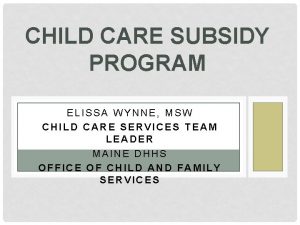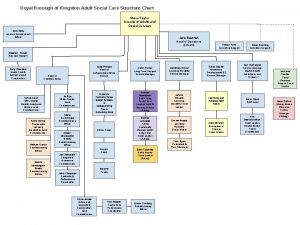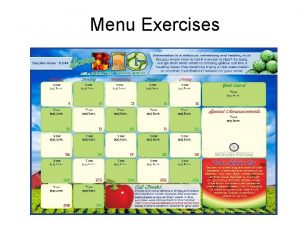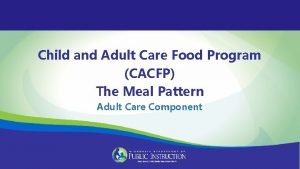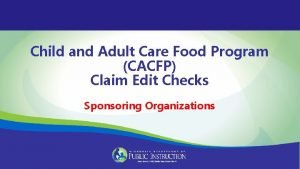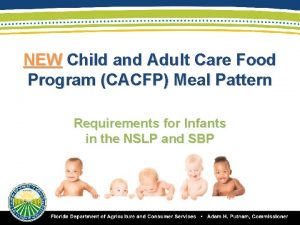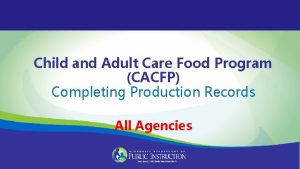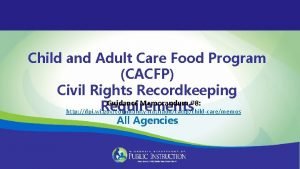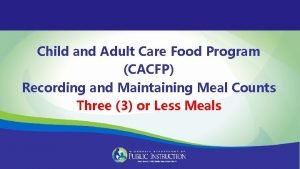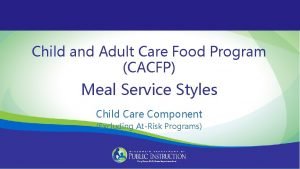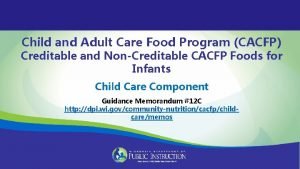Child and Adult Care Food Program CACFP CACFP












- Slides: 12

Child and Adult Care Food Program (CACFP) CACFP Infant Meal Pattern

CACFP Infant Meal Pattern Listed UNDER Guidance Memorandum (GM) #12 C • http: //dpi. wi. gov/communitynutrition/cacfp/childcare/memos

Terms • Infant: baby from birth through 11 months • Infant Formula: iron-fortified infant formula • Exempt Infant Formula visit: http: //www. fda. gov/Food/Guidance. Regulation/Guidance. Do cuments. Regulatory. Information/Infant. Formula/ucm 106456. htm • Medical statement required to claim meals with non-creditable infant formulas (i. e. low-iron or FDA Exempt Infant Formulas)

Terms • Infant Cereal: iron-fortified dry infant cereal • Solid Foods: infant cereal, prepared baby foods, table foods • Developmentally Ready: readiness to eat solid foods • • All infants develop at their own rate When an infant is developmentally ready to eat solid foods you must offer these foods to the infant

Infant Meal Pattern Age Groups: • • Birth through 5 months old 6 through 11 months old

Age Group: Birth through 5 months old

Age Group: 6 through 11 months old

Introducing Solid Foods • When the infant is developmentally ready • Parents/guardians indicate it is okay to serve • Some infants are developmentally ready to eat solid foods before, at, or after 6

Introducing Solid Foods All Ages: • • • Introduce solid foods gradually Offer foods at required meal/snack when infant has established tolerance By 7 or 8 months, infant should be consuming foods from all food groups

Transition from Formula to Whole Milk • • 12 - 13 months: Transition from formula to whole milk After 13 months: Formula is no longer creditable unless a medical statement is on file

Breastmilk for Babies Over 12 Months of Age • • • Continue to serve babies their mother’s milk as long as the mother is able and wishes to provide it No medical statement needed Breastmilk is a substitute for cow’s milk in the meal pattern for children

Non-Discrimination Statement (NDS) In accordance with Federal civil rights law and U. S. Department of Agriculture (USDA) civil rights regulations and policies, the USDA, its Agencies, offices, and employees, and institutions participating in or administering USDA programs are prohibited from discriminating based on race, color, national origin, sex, religious creed, disability, age, political beliefs, or reprisal or retaliation for prior civil rights activity in any program or activity conducted or funded by USDA. Persons with disabilities who require alternative means of communication for program information (e. g. Braille, large print, audiotape, American Sign Language, etc. ), should contact the Agency (State or local) where they applied for benefits. Individuals who are deaf, hard of hearing or have speech disabilities may contact USDA through the Federal Relay Service at (800) 877 -8339. Additionally, program information may be made available in languages other than English. To file a program complaint of discrimination, complete the USDA Program Discrimination Complaint Form, (AD-3027) found online at: http: //www. ascr. usda. gov/complaint_filing_cust. html, and at any USDA office, or write a letter addressed to USDA and provide in the letter all of the information requested in the form. To request a copy of the complaint form, call (866) 632 -9992. Submit your completed form or letter to USDA by: (1) mail: U. S. Department of Agriculture Office of the Assistant Secretary for Civil Rights 1400 Independence Avenue, SW Washington, D. C. 20250 -9410; (2) fax: (202) 690 -7442; or (3) email: program. intake@usda. gov. This institution is an equal opportunity provider.
